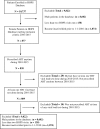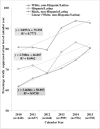Trends of racial and ethnic disparities in virologic suppression among women in the HIV Outpatient Study, USA, 2010-2015
- PMID: 29293632
- PMCID: PMC5749722
- DOI: 10.1371/journal.pone.0189973
Trends of racial and ethnic disparities in virologic suppression among women in the HIV Outpatient Study, USA, 2010-2015
Erratum in
-
Correction: Trends of racial and ethnic disparities in virologic suppression among women in the HIV Outpatient Study, USA, 2010-2015.PLoS One. 2018 Mar 12;13(3):e0194413. doi: 10.1371/journal.pone.0194413. eCollection 2018. PLoS One. 2018. PMID: 29529080 Free PMC article.
Abstract
In the United States, women accounted for 19% of new HIV diagnoses in 2015 and were less likely to reach virologic suppression when compared to men. We assessed trends and disparities in virologic suppression among HIV-positive women to inform HIV treatment strategies. Data were from a prospective cohort of the HIV Outpatient Study and collected at nine United States HIV clinics. We included women aged ≥18 years, with ≥1 visit, who were prescribed antiretroviral therapy, and had ≥1 viral load test performed between 2010 and 2015. We defined virologic suppression as viral load <50 copies/mL and calculated adjusted prevalence ratios (aPR) with 95% confidence intervals (CI) for virologic suppression by race/ethnicity and year of measure. Generalized estimating equations were used for multivariable analyses to assess factors associated with virologic suppression. Among 809 women (median age = 44 years), 482 (60%) were black, 177 (22%) white, 150 (19%) Hispanic/Latina. Virologic suppression was less prevalent among black women (73%) compared with Hispanic/Latina women (83%) and white women (91%). In multivariable analyses, not achieving virologic suppression was more likely among black women (aPR = 2.13; CI = 1.50-3.02) or Hispanic/Latina women (aPR = 1.66; CI = 1.08-2.56) compared with white women, and among women who attended public clinics (aPR = 1.42; CI = 1.07-1.87) compared with those who attended a private clinic. Between 2010 and 2015, virologic suppression among HIV-positive women increased from 68% to 83%, but racial/ethnic disparities persisted. Black and Hispanic/Latina women had significantly lower rates of virologic suppression than white women. Interventions targeting virologic suppression improvement among HIV-positive women of color, especially those who attend public clinics, are warranted.
Conflict of interest statement
Figures



References
-
- Centers for Disease Control and Prevention. HIV surveillance report. Vol. 26; 2015. Available at: http://www.cdc.gov/hiv/pdf/library/reports/surveillance/cdc-hiv-surveill.... Accessed August 18, 2016.
-
- Centers for Disease Control and Prevention. HIV surveillance in women, 2016. Available at: http://www.cdc.gov/hiv/library/slideSets/index.html. Accessed August 22, 2016.
-
- Center for Disease Control and Prevention. HIV among women. Available at: http://www.cdc.gov/hiv/group/gender/women/index.html. Accessed August 18, 2016.
-
- Skarbinski J, Rosenberg E, Paz-Bailey G, Hall HI, Rose CE, Viall AH, et al. Human immunodeficiency virus transmission at each step of the care continuum in the United States. JAMA Intern Med. 2015;175(4):588–596. doi: 10.1001/jamainternmed.2014.8180 - DOI - PubMed
-
- Aberg JA, Gallant JE, Ghanem KG, Emmanuel P, Zingman BS, Horberg MA, et al. HIV. Primary care guidelines for the management of persons infected with human immunodeficiency virus: 2013 update by the HIV medicine association of the Infectious Diseases Society Of America. Clin Infect Dis. 2014;58(5)e1–34. doi: doi: 10.1093/cid/cit665 Epub 2013 Nov 13. - DOI - PubMed
Publication types
MeSH terms
Grants and funding
LinkOut - more resources
Full Text Sources
Other Literature Sources
Medical
Miscellaneous

